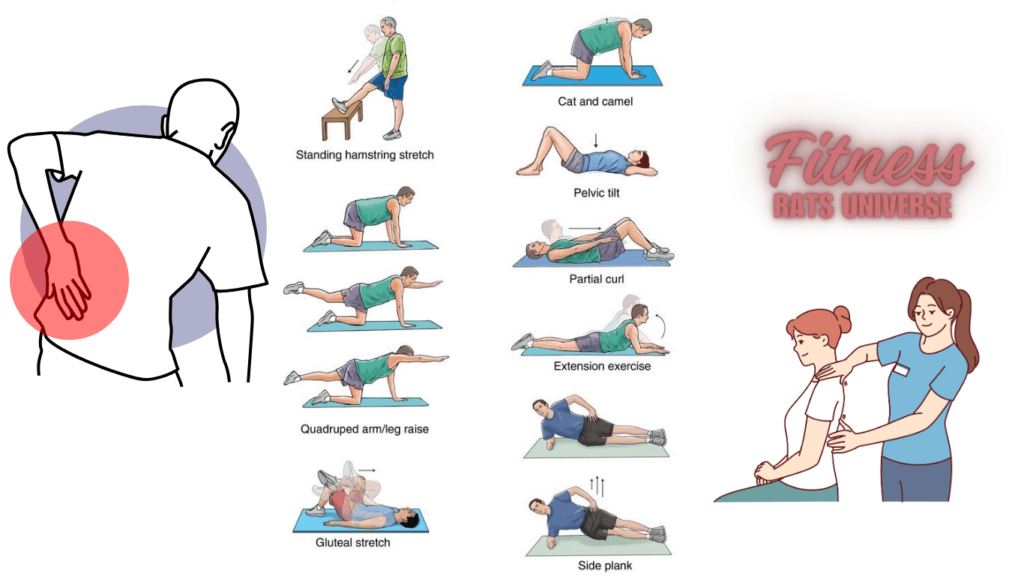Physiotherapy Exercises for Lower Back Pain: A Comprehensive Approach
In this article we will discuss physiotherapy exercises for lower back pain.
Lower back pain is a common affliction affecting millions of people worldwide. From desk workers to athletes, it doesn’t discriminate based on occupation or lifestyle. The discomfort and limitations it imposes can significantly impact daily life, hindering simple tasks and reducing overall quality of life. Whether it’s a dull ache or sharp twinge, lower back pain can range from mildly irritating to severely debilitating, making it crucial to address effectively.
Physiotherapy exercises for lower back pain offer a targeted approach to alleviate discomfort and improve function. Unlike relying solely on medication for temporary relief, these exercises aim to address the root cause of the pain, promoting long-term healing and prevention. By targeting specific muscle groups and improving flexibility and strength, physiotherapy exercises can help individuals regain control over their lower back health and reduce the likelihood of future episodes.

The effectiveness of physiotherapy exercises in managing lower back pain is well-documented. Research consistently highlights their benefits in improving mobility, reducing pain intensity, and enhancing overall function. Additionally, physiotherapy exercises empower individuals to take an active role in their recovery, fostering a sense of ownership and control over their health journey.
Moreover, incorporating physiotherapy exercises into a regular routine can serve as a proactive measure against lower back pain. By strengthening core muscles, improving posture, and enhancing flexibility, individuals can fortify their bodies against common triggers of lower back discomfort, such as poor posture and muscle imbalances.
Subscribe And Get Our Free E-Book:Unlocking The Power Of Nutrition-Supplements, Substitutes, and Superfoods!
The holistic approach of physiotherapy exercises addresses not only the symptoms but also the underlying causes of lower back pain. Rather than simply masking the pain, these exercises promote healing and resilience, leading to sustainable relief and improved overall well-being.
In the next sections of this blog series, we will explore a variety of physiotherapy exercises specifically tailored to target lower back pain. From gentle stretches to dynamic strengthening exercises, each technique is designed to alleviate discomfort, improve mobility, and prevent future episodes. Whether you’re dealing with acute or chronic lower back pain, incorporating these exercises into your routine can make a significant difference in your quality of life.
Stay tuned as we delve deeper into the world of physiotherapy exercises for lower back pain and discover how you can take control of your lower back health. Remember, with dedication and consistency, you can pave the way towards a pain-free and active lifestyle.
Understanding Lower Back Pain
Understanding lower back pain is essential for effectively managing and preventing its impact on daily life. There are various factors that can contribute to this discomfort, ranging from poor posture to muscle strain and injury. By delving into the causes, symptoms, and the importance of early intervention, individuals can gain insight into the significance of addressing lower back pain promptly.
One of the primary causes of lower back pain is poor posture. In today’s sedentary lifestyle, prolonged sitting and slouching can place excessive strain on the muscles and ligaments of the lower back, leading to discomfort and stiffness. Additionally, activities that involve repetitive motions or heavy lifting can also contribute to muscle strain, resulting in acute or chronic pain in the lower back region.
Muscle strain is another common culprit behind lower back pain. Whether it’s from lifting a heavy object incorrectly or engaging in strenuous physical activity without proper warm-up, overexertion can cause micro-tears in the muscles of the lower back, triggering pain and inflammation. Furthermore, sudden movements or awkward twisting motions can exacerbate existing muscle strain, intensifying the discomfort.
Injury, whether from sports-related incidents or accidents, can also lead to lower back pain. Impact injuries, such as falls or collisions, can cause trauma to the muscles, ligaments, or vertebrae of the lower back, resulting in acute pain and restricted mobility. Similarly, repetitive stress injuries, such as those commonly seen in athletes or individuals with physically demanding jobs, can gradually wear down the structures of the lower back, leading to chronic pain and dysfunction.
Recognizing the symptoms of lower back pain is crucial for early intervention and management. Individuals with lower back pain often experience stiffness, soreness, and aching sensations in the lower back region. This discomfort may radiate down the legs, causing tingling or numbness, known as sciatica. Additionally, activities that involve bending, lifting, or twisting may exacerbate the pain, limiting mobility and hindering daily activities.

Limited mobility is another hallmark symptom of lower back pain, as individuals may struggle to perform simple tasks such as bending down to tie their shoes or reaching overhead. The pain and stiffness can significantly impact quality of life, affecting work performance, leisure activities, and even sleep quality. Furthermore, the psychological toll of chronic pain can lead to anxiety, depression, and reduced overall well-being.
Addressing lower back pain early is paramount to preventing it from worsening and impacting quality of life. Ignoring the discomfort or relying solely on medication for temporary relief can lead to further complications and long-term consequences. Physiotherapy exercises for lower back pain offer a proactive approach to addressing the root cause of the pain, promoting healing, and preventing future episodes.
By targeting specific muscle groups, improving flexibility, and strengthening the core, physiotherapy exercises can alleviate discomfort, improve function, and reduce the likelihood of recurrent lower back pain. Moreover, seeking professional guidance from a physiotherapist can ensure that exercises are performed correctly and safely, maximizing their effectiveness and minimizing the risk of injury.
Understanding the causes, symptoms, and importance of early intervention in lower back pain is essential for effectively managing and preventing its impact on daily life. By addressing the root cause of the pain through physiotherapy exercises, individuals can regain control over their lower back health and enjoy a pain-free and active lifestyle. Remember, taking proactive steps to address lower back pain early can make a significant difference in your overall well-being.
Physiotherapy Exercises For Low Back Pain Video
The Effectiveness of Physiotherapy Exercises for Lower Back Pain
Physiotherapy exercises for lower back pain offer a multitude of benefits, not only in alleviating discomfort but also in promoting overall well-being. By targeting specific muscle groups, improving flexibility, and promoting proper alignment, these exercises play a crucial role in managing and preventing lower back pain.
One of the primary benefits of physiotherapy exercises for lower back pain is their ability to strengthen muscles. By engaging in targeted exercises that focus on the muscles of the core, back, and pelvis, individuals can build strength and stability in these areas, reducing the risk of injury and improving overall function. Stronger muscles provide better support for the spine, reducing strain and pressure on the lower back, thus alleviating pain and discomfort.
In addition to strengthening muscles, physiotherapy exercises also help improve flexibility. Tight muscles and restricted range of motion can contribute to lower back pain by placing undue stress on the spine and surrounding structures. Through stretching and mobility exercises, individuals can increase flexibility and range of motion, allowing for smoother, more fluid movement and reducing the likelihood of muscle strain and injury.
Furthermore, physiotherapy exercises promote proper alignment, which is crucial for preventing and managing lower back pain. Poor posture and misalignment can exacerbate lower back pain by placing uneven pressure on the spine and contributing to muscle imbalances. By incorporating exercises that focus on posture awareness and spinal alignment, individuals can correct imbalances, improve posture, and reduce strain on the lower back.

The effectiveness of physiotherapy exercises in managing and preventing lower back pain is supported by a wealth of evidence. Numerous studies have demonstrated the benefits of exercise-based interventions in reducing pain intensity, improving function, and enhancing quality of life for individuals with lower back pain. From randomized controlled trials to systematic reviews, the evidence consistently highlights the positive impact of physiotherapy exercises on lower back pain outcomes.
Moreover, physiotherapy exercises are often recommended as a first-line treatment for lower back pain due to their safety and efficacy. Unlike medications or invasive procedures, which may carry risks and side effects, physiotherapy exercises offer a non-invasive and holistic approach to addressing lower back pain. By empowering individuals to take an active role in their recovery, physiotherapy exercises promote long-term healing and prevention, rather than merely providing temporary relief.
In conclusion, physiotherapy exercises for lower back pain offer a comprehensive approach to managing and preventing discomfort, while promoting overall health and well-being. By strengthening muscles, improving flexibility, and promoting proper alignment, these exercises address the root causes of lower back pain, rather than merely masking symptoms. Supported by a robust body of evidence, physiotherapy exercises are a safe and effective option for individuals seeking relief from lower back pain and wishing to maintain a healthy, active lifestyle.
Key Physiotherapy Exercises
Physiotherapy exercises for lower back pain encompass a variety of techniques designed to target specific muscle groups, improve flexibility, correct posture, and enhance mobility. By incorporating key exercises into a regular routine, individuals can effectively manage and prevent lower back pain, promoting overall health and well-being.
Core strengthening exercises are essential for stabilizing the spine and reducing strain on the lower back muscles. The plank, bridge, and bird dog are examples of exercises that target the core muscles, including the abdominals, obliques, and lower back muscles. By engaging these muscles, individuals can improve stability and support for the spine, reducing the risk of injury and alleviating lower back pain.
Flexibility exercises play a crucial role in relieving tension and improving range of motion in the lower back and surrounding muscles. The cat-cow stretch and seated spinal twist are examples of stretches that can help alleviate stiffness and discomfort in the lower back. By incorporating these stretches into a daily routine, individuals can increase flexibility and reduce the likelihood of muscle strain and injury.
Posture correction exercises are important for promoting proper alignment and reducing strain on the lower back. Poor posture can contribute to lower back pain by placing uneven pressure on the spine and surrounding structures. Exercises such as shoulder blade squeezes and chin tucks can help correct imbalances and improve posture, reducing the risk of pain and discomfort.
Mobility exercises are essential for maintaining flexibility and range of motion in the lower back, hips, and pelvis. Tightness in these areas can contribute to lower back pain by limiting movement and causing muscle imbalances. Hip flexor stretches and pelvic tilts are examples of exercises that can help improve mobility and reduce stiffness in the lower back region.
Physiotherapy Exercises for Lower Back Pain: Summary Chart
| Exercise | Targeted Muscle Groups | Benefits | Additional Info | Safety Tips |
|---|---|---|---|---|
| Plank | Core muscles including | Strengthens core muscles, provides stability for | Variations include side planks, plank with leg lifts, | Ensure proper form with a neutral spine to prevent |
| abdominals, obliques, | the spine, reduces strain on lower back muscles. | and plank on unstable surfaces like a stability ball. | strain on the lower back. Engage core muscles | |
| and lower back muscles. | throughout the exercise. | |||
| Bridge | Glutes, hamstrings, and | Strengthens posterior chain muscles, improves | Add resistance by placing a resistance band around | Keep the feet hip-width apart and avoid arching |
| lower back muscles. | stability and support for the spine. | the thighs. Progress to single-leg bridges for | the back excessively. Focus on lifting the hips | |
| increased challenge. | without overarching the spine. | |||
| Bird Dog | Core muscles, lower back | Improves core stability, enhances balance, | Focus on maintaining a neutral spine and avoid | Keep the neck aligned with the spine and avoid |
| muscles, and glutes. | strengthens muscles supporting the spine. | arching or rounding the back. Engage the core | overarching the back or lifting the leg too high. | |
| throughout the movement. | ||||
| Cat-Cow Stretch | Spinal erectors, abdominals, | Increases flexibility and mobility in the spine, | Perform slow, controlled movements and focus on | Move gently between cat and cow positions, |
| and obliques. | reduces stiffness and tension in the lower back. | breathing deeply to enhance the stretch. | coordinating movement with breath. | |
| Seated Spinal Twist | Rotator muscles, obliques, | Releases tension in the spine, improves flexibility | Keep the spine tall and gently twist from the | Avoid forcing the twist and listen to your body’s |
| and lower back muscles. | and range of motion, enhances spinal mobility. | waist, engaging the core for support. | limits. Stop if you experience discomfort. | |
| Shoulder Blade Squeezes | Rhomboids, trapezius, | Corrects posture, strengthens upper back muscles, | Focus on squeezing the shoulder blades together | Avoid shrugging the shoulders or tensing the |
| and posterior deltoids. | reduces strain on lower back. | without elevating the shoulders. | neck muscles during the exercise. | |
| Chin Tucks | Neck flexors, cervical | Improves posture, reduces strain on the neck and | Gently draw the chin back, creating a double chin, | Avoid tilting the head backward excessively or |
| spine muscles. | upper back, promotes proper alignment of the spine. | without tucking the chin too forcefully. | compressing the cervical spine. | |
| Hip Flexor Stretches | Hip flexors, quadriceps, | Increases flexibility in the hips, reduces tension | Maintain a slight pelvic tilt to deepen the stretch, | Keep the back straight and avoid overarching |
| and lower back muscles. | in the lower back, improves posture. | and avoid arching the lower back. | the lower back. | |
| Pelvic Tilts | Abdominals, lower back | Improves pelvic alignment, strengthens core muscles, | Perform pelvic tilts with control, focusing on | Avoid arching the back excessively during |
| muscles, and glutes. | reduces lower back pain. | engaging the core and avoiding excessive movement. | anterior tilting. Focus on the movement of | |
| Incorporate pelvic tilts into daily activities like | the pelvis rather than the lower back. | |||
| sitting and standing to promote awareness. |
Incorporating these key physiotherapy exercises into a regular routine can help individuals effectively manage and prevent lower back pain. By strengthening the core, improving flexibility, correcting posture, and enhancing mobility, individuals can address the root causes of lower back pain and promote overall spinal health. Remember, consistency is key when it comes to seeing results from physiotherapy exercises for lower back pain. By making these exercises a priority in your daily routine, you can take control of your lower back health and enjoy a pain-free and active lifestyle.
Incorporating Physiotherapy Exercises for Lower Back Pain into Your Daily Routine
Incorporating physiotherapy exercises for lower back pain into your daily routine is essential for effectively managing discomfort and promoting spinal health. By following these tips and guidelines, individuals can seamlessly integrate exercises into their daily activities, making it easier to stay consistent and see lasting improvements in lower back pain.
First and foremost, it’s crucial to start slowly when incorporating physiotherapy exercises into your routine. Begin with gentle exercises that target the core muscles and promote flexibility in the lower back and surrounding areas. As you become more comfortable with these exercises, gradually increase the intensity and duration to challenge your muscles and further improve strength and flexibility.
Consistency is key when it comes to seeing results from physiotherapy exercises for lower back pain. Make a commitment to perform your exercises regularly, ideally on a daily basis, to maximize their effectiveness. Set aside dedicated time each day to focus on your exercises, whether it’s first thing in the morning, during your lunch break, or in the evening before bed. By making exercise a priority and sticking to a consistent routine, you can build strength, improve flexibility, and reduce the frequency and intensity of lower back pain over time.

Listening to your body is essential when incorporating physiotherapy exercises into your routine. Pay attention to how your body responds to each exercise and modify as needed to avoid exacerbating pain or discomfort. If you experience sharp or shooting pain during an exercise, stop immediately and reassess your technique or seek guidance from a physiotherapist. Remember, it’s important to work within your limits and gradually progress as your strength and flexibility improve.
In addition to dedicated exercise sessions, it’s beneficial to incorporate movement throughout the day to promote spinal health and reduce lower back pain. Take regular breaks from sitting or standing desks to stretch and move around, focusing on exercises that target the muscles of the lower back, hips, and pelvis. Simple activities such as walking, gentle stretching, and posture correction exercises can help alleviate stiffness and tension in the lower back, improving overall comfort and well-being.
Incorporating physiotherapy exercises for lower back pain into your daily routine doesn’t have to be complicated or time-consuming. By starting slowly, staying consistent, listening to your body, and incorporating movement throughout the day, you can effectively manage discomfort and promote spinal health. Remember, consistency is key when it comes to seeing results from physiotherapy exercises, so make a commitment to prioritize your exercises and make them a regular part of your daily routine. With dedication and persistence, you can take control of your lower back health and enjoy a pain-free and active lifestyle.
Additional Strategies
Managing lower back pain goes beyond just physiotherapy exercises; it involves incorporating a variety of strategies into your daily routine to promote comfort and well-being. By making ergonomic adjustments, practicing mind-body techniques, and exploring complementary approaches, individuals can effectively manage lower back pain and improve overall quality of life.
Ergonomic adjustments play a significant role in reducing strain on the lower back and preventing discomfort. Whether at work or at home, creating an ergonomic workspace can help promote proper posture and reduce the risk of aggravating lower back pain. Ensure that your desk, chair, and computer setup are ergonomically designed to support good posture and minimize strain on the spine. Consider using a supportive chair with adjustable lumbar support, positioning your monitor at eye level to prevent neck strain, and taking regular breaks to stretch and move around. Additionally, making simple adjustments to your sleeping position, such as using a supportive mattress and pillows, can help maintain spinal alignment and alleviate pressure on the lower back while you sleep.
Mind-body techniques offer another avenue for managing lower back pain and promoting relaxation. Practices such as yoga, tai chi, and mindfulness meditation have been shown to reduce stress, improve flexibility, and alleviate symptoms of lower back pain. These gentle, low-impact exercises focus on breath awareness, gentle movement, and mindfulness, helping individuals cultivate a greater sense of body awareness and reduce tension in the muscles of the lower back and surrounding areas. Incorporating mind-body techniques into your daily routine can complement physiotherapy exercises and provide additional relief from lower back pain.
Furthermore, exploring complementary approaches to managing lower back pain can offer additional support and relief. Techniques such as acupuncture, massage therapy, and chiropractic care can help alleviate muscle tension, improve circulation, and promote healing in the lower back region. These complementary therapies can be used in conjunction with physiotherapy exercises to address the underlying causes of lower back pain and enhance overall well-being.
Incorporating additional strategies for managing lower back pain into your daily routine can help alleviate discomfort and improve quality of life. By making ergonomic adjustments, practicing mind-body techniques, and exploring complementary approaches, individuals can take a proactive approach to managing their lower back pain and promoting spinal health. Remember, finding the right combination of strategies that work for you may take time, so be patient and persistent in your efforts to find relief from lower back pain. With dedication and consistency, you can take control of your lower back health and enjoy a pain-free and active lifestyle.
Concluding with Physiotherapy Exercises for Lower Back Pain Relief
Throughout this series, we’ve explored the importance of physiotherapy exercises for lower back pain and various strategies for managing and preventing discomfort. From understanding the causes and symptoms of lower back pain to incorporating key exercises into your daily routine, we’ve covered a range of topics aimed at helping you take control of your lower back health.
Physiotherapy exercises for lower back pain are a cornerstone of effective management and prevention. By targeting specific muscle groups, improving flexibility, and promoting proper alignment, these exercises address the root causes of lower back pain, rather than merely masking symptoms. Through core strengthening exercises, flexibility exercises, posture correction exercises, and mobility exercises, individuals can alleviate discomfort, improve function, and reduce the likelihood of recurrent lower back pain episodes.
In addition to physiotherapy exercises, we’ve explored additional strategies for managing lower back pain, such as ergonomic adjustments, mind-body techniques, and complementary approaches. Making ergonomic adjustments to your workspace and sleeping environment, practicing mind-body techniques like yoga and mindfulness meditation, and exploring complementary therapies like acupuncture and massage can provide additional relief and support for managing lower back pain.
As you embark on your journey to manage and prevent lower back pain, it’s important to remember the significance of consistency and dedication. Incorporating physiotherapy exercises and strategies into your daily routine is key to seeing long-term relief and improved overall well-being. Start slowly, stay consistent, and listen to your body as you gradually increase the intensity and duration of your exercises. Remember to make ergonomic adjustments to your workspace, practice mind-body techniques regularly, and explore complementary therapies as needed to support your lower back health.
I encourage you to incorporate the discussed exercises and strategies into your daily routine and to share your own experiences in the comments section below. By sharing your journey with others, you can offer support and encouragement to fellow readers who may be facing similar challenges with lower back pain.
Finally, don’t forget to subscribe to our newsletter to receive updates and additional tips for managing lower back pain and promoting spinal health. By staying informed and engaged, you can continue to take proactive steps towards a pain-free and active lifestyle. Thank you for joining us on this journey, and here’s to your lower back health and well-being!


